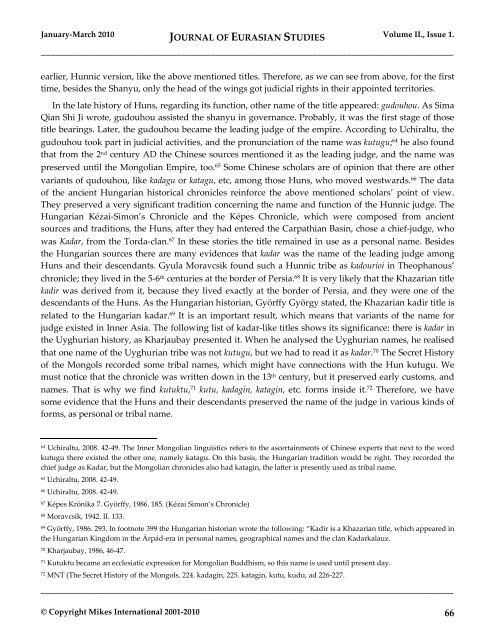EurasianStudies_0110..
EurasianStudies_0110..
EurasianStudies_0110..
Create successful ePaper yourself
Turn your PDF publications into a flip-book with our unique Google optimized e-Paper software.
January-March 2010 JOURNAL OF EURASIAN STUDIES Volume II., Issue 1.<br />
_____________________________________________________________________________________<br />
earlier, Hunnic version, like the above mentioned titles. Therefore, as we can see from above, for the first<br />
time, besides the Shanyu, only the head of the wings got judicial rights in their appointed territories.<br />
In the late history of Huns, regarding its function, other name of the title appeared: gudouhou. As Sima<br />
Qian Shi Ji wrote, gudouhou assisted the shanyu in governance. Probably, it was the first stage of those<br />
title bearings. Later, the gudouhou became the leading judge of the empire. According to Uchiraltu, the<br />
gudouhou took part in judicial activities, and the pronunciation of the name was kutugu; 64 he also found<br />
that from the 2 nd century AD the Chinese sources mentioned it as the leading judge, and the name was<br />
preserved until the Mongolian Empire, too. 65 Some Chinese scholars are of opinion that there are other<br />
variants of qudouhou, like kadagu or katagu, etc, among those Huns, who moved westwards. 66 The data<br />
of the ancient Hungarian historical chronicles reinforce the above mentioned scholars’ point of view.<br />
They preserved a very significant tradition concerning the name and function of the Hunnic judge. The<br />
Hungarian Kézai-Simon’s Chronicle and the Képes Chronicle, which were composed from ancient<br />
sources and traditions, the Huns, after they had entered the Carpathian Basin, chose a chief-judge, who<br />
was Kadar, from the Torda-clan. 67 In these stories the title remained in use as a personal name. Besides<br />
the Hungarian sources there are many evidences that kadar was the name of the leading judge among<br />
Huns and their descendants. Gyula Moravcsik found such a Hunnic tribe as kadourioi in Theophanous’<br />
chronicle; they lived in the 5-6 th centuries at the border of Persia. 68 It is very likely that the Khazarian title<br />
kadir was derived from it, because they lived exactly at the border of Persia, and they were one of the<br />
descendants of the Huns. As the Hungarian historian, Györffy György stated, the Khazarian kadir title is<br />
related to the Hungarian kadar. 69 It is an important result, which means that variants of the name for<br />
judge existed in Inner Asia. The following list of kadar-like titles shows its significance: there is kadar in<br />
the Uyghurian history, as Kharjaubay presented it. When he analysed the Uyghurian names, he realised<br />
that one name of the Uyghurian tribe was not kutugu, but we had to read it as kadar. 70 The Secret History<br />
of the Mongols recorded some tribal names, which might have connections with the Hun kutugu. We<br />
must notice that the chronicle was written down in the 13 th century, but it preserved early customs, and<br />
names. That is why we find kutuktu, 71 kutu, kadagin, katagin, etc. forms inside it. 72 Therefore, we have<br />
some evidence that the Huns and their descendants preserved the name of the judge in various kinds of<br />
forms, as personal or tribal name.<br />
64 Uchiraltu, 2008. 42-49. The Inner Mongolian linguistics refers to the ascertainments of Chinese experts that next to the word<br />
kutugu there existed the other one, namely katagu. On this basis, the Hungarian tradition would be right. They recorded the<br />
chief judge as Kadar, but the Mongolian chronicles also had katagin, the latter is presently used as tribal name.<br />
65 Uchiraltu, 2008. 42-49.<br />
66 Uchiraltu, 2008. 42-49.<br />
67 Képes Krónika 7. Györffy, 1986. 185. (Kézai Simon’s Chronicle)<br />
68 Moravcsik, 1942. II. 133.<br />
69 Györffy, 1986. 293. In footnote 399 the Hungarian historian wrote the following: “Kadir is a Khazarian title, which appeared in<br />
the Hungarian Kingdom in the Árpád-era in personal names, geographical names and the clan Kadarkalauz.<br />
70 Kharjaubay, 1986, 46-47.<br />
71 Kutuktu became an ecclesiatic expression for Mongolian Buddhism, so this name is used until present day.<br />
72 MNT (The Secret History of the Mongols. 224. kadagin, 225. katagin, kutu, kudu, ad 226-227.<br />
_____________________________________________________________________________________<br />
© Copyright Mikes International 2001-2010 66

















